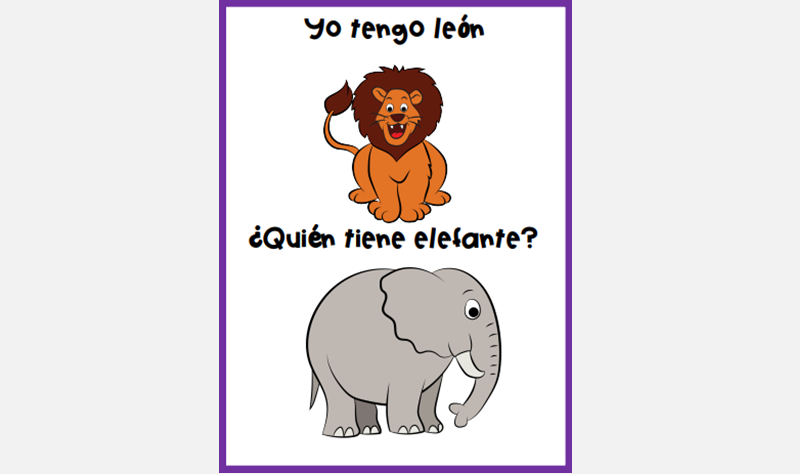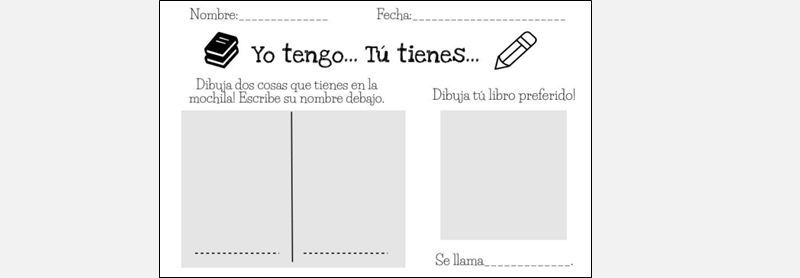Tener/Have
WAYS WE CAN USE THE WORD(S)
SHARE INFORMATION: e.g., Tengo hambre (I’m hungry).
ASK QUESTIONS: e.g., ¿Tienes mi pelota? (Do you have my ball?)
WARN: e.g., Ten cuidado (Be careful).
COMMENT: e.g., Lo tengo (I have it).
COMMENT: e.g., Tengo 8 años (I’m 8 years old).
DESCRIBE: e.g., Tengo el pelo castaño (I have brown hair).
EXPRESSING FEAR: e.g., Tengo miedo (I’m scared).
CONJUGATIONS FOR PRESENT AND PAST (PRETÉRITO INDEFINIDO)
|
SUBJECT |
PRESENT |
PAST |
|
I |
Tengo |
Tuve |
|
You |
Tienes |
Tuviste |
|
He/She/You (Formal) |
Tiene |
Tuvo |
|
We |
Tenemos |
Tuvimos |
|
They/You All |
Tienen |
Tuvieron |
This core words activity worksheet was created by Angela Rowell. It was adapted from the School Year of Core Words worksheet for “have” by Beth Kenney, who can be contacted at bkenney@hershey.k12.pa.us.
Snack/mealtimes: During mealtime or snack time, the adult can describe the food that the student is going to eat, e.g., “Tienes una manzana y una galleta” (You have an apple and a cookie).
Transitioning between activities: When transitioning between activities, adults can use the prompt “Ahora tienes que…” (Now you have to…) in order to direct students towards the upcoming activities/action, e.g., “Ahora tienes que lavarte las manos” (Now you have to wash your hands).

Recess: During recess, adults can prompt students to label the toys or items that they are interacting with, e.g., “¿Qué tienes ahí?” (What do you have there?)
Who/What Am I? Game: In this game, students are assigned unique identities, such as animals or well-known people. Students then ask each other questions (including questions with the verb “tener”) in order to discover their classmates’ identities, e.g., “¿Tienes cola?” (Do you have a tail?)
I Have… Game: In this activity, students are given cards with animals on them. The students must say which animal they have, and ask other students which animals they have on their cards. This resource is available for free on the Teachers Pay Teachers website.

This game can also be played with numbers. This resource is also available for free on the Teachers Pay Teachers website.
Bingo: The adult can prepare a bingo game for students. Students who have the item that is called on their board can be prompted to call out, “¡Lo tengo!” (I have it!)
Two Truths and a Lie: Students can play Two Truths and a Lie, using the core word. Other students will have to guess which sentences are true and which are false. Students could create sentences such as “tengo tres hermanos” (I have two brothers/siblings), “tengo chocolate en mi mochila” (I have chocolate in my backpack), etc.
Here are some suggested books on YouTube that can assist in teaching the core word:
- Cuando tengo miedo: By Trace Moroney | Children's Book Read Aloud by Eliana Riaños
- This story discusses the theme of being afraid by giving various examples of the things and situations that scare the protagonist. The book teaches the lesson that many things that seem scary really aren’t so bad in reality.
- Yo te tengo a ti y tu me tienes a mi: By Nele Moost and Michael Schober| Children's Book Read Aloud by Erika Patricia Téllez García and Gabriela Anahí Ramírez Domínguez
- This story reveals how strong the love between a child and their parent is, shown through examples and illustrations involving a father bear and his child.
- Tengo un volcán: By Míriam Tirado Torras| Children's Book Read Aloud by Cuentos Para Todos
- This story, which is recommended for students who are context-dependent or independent communicators, explores the topic of anger. The protagonist, Alba, slowly learns how to control her anger after receiving advice from a fairy.
Social Interactions: Students can be prompted to get to know each other better by asking each other questions involving the verb “tener,” e.g., “¿Tienes hermanos?” (Do you have siblings?)
Modeling: The adult can model how to find the verb “tener” on the student’s communication device and model how to combine the core word into multi-word utterances.
A classroom poster that can aid instruction on various communicative functions of the verb “tener” is available for free on the Teachers Pay Teachers website.

Guessing Game: Students can take turns being blindfolded as the adult hands them various mystery items. The student must guess which item that adult has handed them. The adult can use utterances such as, “¿Qué tienes en la mano?” (What do you have in your hand?)
Hot and Cold Activity: The adult can prepare two bowls: one filled with ice or cold water, and one filled with warm water. The adult can begin the activity by allowing students to put their hands into the bowls in order to feel the difference. Students can practice using the expressions “Tengo frío” (I’m cold) and “Tengo calor” (I’m hot) while alternating their hands between the bowls. The adult can also put a rubber duck, or a similar object, into the water so that students can practice describing how the duck would feel, e.g., “Tiene frío” (He/she is cold) or “Tiene calor” (He/she is hot).
All About Me: For this activity, students will be prompted to describe their own physical appearance to the class, incorporating the verb “tener,” e.g., “Tengo el pelo rizado y los ojos marrones” (I have curly hair and brown eyes). Students can also draw themselves if they wish.
Math Activity: Students can practice addition, subtraction, multiplication, and division by completing word problems with the core word. Adults can create prompts such as, “Tienes 3 manzanas. Luego encuentras 2 más. Ahora, ¿cuántas manzanas tienes?” (You have 3 apples. Then you find 2 more. Now, how many apples do you have?)
Literacy Activity: Read the short story, “Tengo frío,” available for free on the Teachers Pay Teachers website. This story includes repetition and less than 25 vocabulary words.

- Yo tengo un cuerpo y lo voy a mover | Children’s Song | By Coreokids
- Tengo dos manitas | Children’s Song | By Canciones Infantiles - Loo Loo
- Yo tengo un tic | Children’s Song | By El Reino Infantil
- Tengo tengo tengo 3 ovejas | Children’s Song | By ChiquitinesTV
- Yo tengo una casita | Children’s Song | By Luli Pampín
- Tengo una mascota | Children’s Song | By Super Simple Español - Canciones Infantiles Y Más
- Si usted tiene muchas ganas de aplaudir| Children’s Song | By El Reino Infantil
- Tengo una mascota ¿Cómo cuidar a nuestras mascotas?| Educational Video | By Mely Gaytan
- This educational video explains to students how to properly care for a pet, with many visual examples.
Art Activity: Students can draw pictures of their families and then present their drawings to the class, explaining who they have in their families, e.g., “Tengo una mamá, un papá y dos hermanas” (I have a mom, a dad, and two sisters).
Art Activity: Students can draw what they have in their backpacks or pencil cases. This activity can be done on blank paper or using a worksheet available for free on the Teachers Pay Teachers website.

Make Your Own Pizza: Students can create virtual pizzas via this Boom Cards activity, and then describe what kind of pizza they have, e.g., “Tengo una pizza de queso y pepperoni” (I have a cheese and pepperoni pizza). Students can also describe other students’ pizzas.
Make Your Own Donut: Students can create virtual donuts via this Boom Cards activity, and then describe what kind of donut they have, using the core word. Students can also describe other students’ donuts.
Tarheel Reader: Students can use Tarheel Reader to write books using the core word tener. These books can then be shared with other students and read aloud.
Creating Videos: The students can record videos in which they show their favorite toys or personal objects that they have, using the core word tener.
WORD WALL: Create a Word Wall and add tener to the list.
READING and the Word Wall: Sound out the letters together. Have the students find the word on the AAC system.
WRITING and the Word Wall: Using a pencil or alternative pencil, have students try to type the word on the keyboard, adapted keyboard or write the word together.
Choosing Words for the Classroom Word Wall with Dr Caroline Musselwhite Video. Courtesy of Edmonton Regional Learning Consortium.